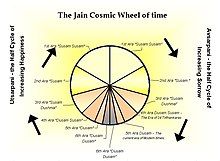Kāla
This article needs additional citations for verification. (June 2011) |

Kala (
Etymology
- kāla 1 means "black, of a dark colour, dark-blue ..." and has a feminine form ending in ī – kālī – as mentioned in Pāṇini 4–1, 42.
- kālá 2 means "a fixed or right point of time, a space of time, time ... destiny, fate ... death" and has a feminine form (found at the end of compounds) ending in ā, as mentioned in the ṛgveda Prātiśākhya. As a traditional Hindu unit of time, one kālá corresponds to 144 seconds.
According to Monier-Williams, kāla 2 is from the verbal root kal "to calculate", while the root of kāla 1 is uncertain, though possibly the same.[4]
As applied to gods and goddesses in works such as the Devī Māhātmya and the Skanda Purāṇa, kāla 1 and kāla 2 are not readily distinguishable. Thus Wendy Doniger, translating a conversation between Śiva and Pārvatī from the Skanda Purāṇa, says Mahākāla may mean " 'the Great Death' ... or 'the Great Black One' ".[6] And Swāmī Jagadīśvarānanda, a Hindu translator of the Devī Māhātmya, renders the feminine compound kāla-rātri (where rātri means "night") as "dark night of periodic dissolution".[7]
Deity

Epics and the Puranas
Kala appears as an impersonal deity within the
Kala appears in the
Time appears in the Bhagavata Purana as the force that is responsible for the imperceptible and inevitable change in the entire creation. According to the Purana, all created things are illusory, and thereby subject to creation and annihilation, this imperceptible and inconceivable impermanence is said to be due to the march of Time. Similarly, Time is considered to be the unmanifest aspect of God that remains after the destruction of the entire world at the end of a lifespan of Brahma. According to Soifer, Narasimha is explicitly linked with Pralaya or Yuganta itself in Bhagavata Purana, Linga Purana, and Kurma Purana versions; he is said to appear like Kala or the fire of destruction, both agents of Pralaya.[5]
In the Chaitanya Bhagavata, a Gaudiya Vaishnava text and biography of Chaitanya Mahaprabhu, it is said that the fire that emerges from the mouth of Sankarshana at the End of Time is the Kālānala, or "fire of Time".[8] One of the names of Sankarshana is kālāgni, also "fire of time".[9]
The
Bhagavad Gita
At Bhagavad Gita 11.32, Krishna takes on the form of kāla, the destroyer, announcing to Arjuna that all the warriors on both sides will be killed, apart from the Pandavas:
कालो ऽस्मि लोकक्षयकृत् प्रवृद्धो लोकान् समाहर्तुम् इह प्रवृत्तः ।
This verse means: "Time (kāla) I am, the great destroyer of the worlds, and I have come here to destroy all people."[13] This phrase is famous for being quoted by J. Robert Oppenheimer as he reflected on the Manhattan Project's explosion of the first nuclear bomb in 1945.
In other cultures
In Javanese mythology,
In
In Thailand, he is popular worshipped together with Lak Mueang within Tai folk religion and Chitragupta in Hinduism.[14]
Jainism


In Jainism, Kāla (Time) is infinite and is explained in two different ways:
- The measure of duration, known in the form of hours, days, like that.
- The cause of the continuity of function of things.
However
See also
References
- ^ "ศาลหลักเมืองกรุงเทพมหานคร (Bangkok City Pillar Shrine)".
- ^ www.wisdomlib.org (14 September 2019). "Kalam: 6 definitions". www.wisdomlib.org. Retrieved 4 November 2022.
- ^ Dalal 2011, p. 185.
- ^ a b c d Monier-Williams, Monier (1899). "Sanskrit Dictionary". Retrieved 4 October 2023.
- ^ a b Soifer 1991, p. 102.
- ISBN 0-14-044306-1footnote to page 253.
- ^ Jagadīśvarānanda trans; Devi Mahatmyam (Sanskrit and English); Sri Ramakrishna Math, Madras, 1953; chapter 1 verse 78.
- ^ Thakura, Vrndavana Dasa. Chaitanya-Bhagavata. Translated by Sarvabhavana Dasa. p. 203.
- ^ "A Thousand Names of Lord Balarama".
- ^ Wilson, Horace H. (1840). "Preface". The Vishńu Puráńa: A System of Hindu Mythology and Tradition. pp. ix.
- ^ Roy, Janmajit (2002). "Signs and Symptoms of Avatārahood". Theory of Avatāra and Divinity of Chaitanya. New Delhi: Atlantic Publishers & Distributors. p. 66.
- ^ Pintchman 2001, p. 83.
- ^ See text and translation
- ^ "ศาลหลักเมืองกรุงเทพมหานคร (Bangkok City Pillar Shrine)".
Sources
- Dalal, Roshen (5 October 2011). Hinduism: An Alphabetical Guide. Penguin Books India. ISBN 978-0-14-341421-6. Retrieved 19 December 2012.
- Pintchman, Tracy, ed. (2001), Seeking Mahadevi: Constructing the Identities of the Hindu Great Goddess, SUNY Press
- Soifer, Deborah A. (1991). The Myths of Narasimha and Vamana: Two Avatars in Cosmological Perspective. SUNY Press. ISBN 9780791407998.

